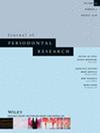To explore the association between periodontitis and olfactory disorders.
Clinical data were collected from 198 individuals between the ages of 18 and 60 years living in Denmark. The exposure was periodontitis, and the outcome was olfactory function (Threshold, Discrimination, Identification – TDI score), both measured clinically. Covariates included sex, age, education level, income, usage of nasal spray, tongue coating, halitosis, xerostomia, smoking, and history of COVID-19. Structural equation modeling was used to estimate the association between periodontitis and olfactory function. Periodontitis was defined using the AAP/EFP classification and dichotomized into “no” (healthy subjects) and “yes” (Stages I, II, and III). Olfactory function was treated as a one-factor latent variable, including the different olfactory scores. In addition, extra models were performed considering each olfactory component as a separate outcome and the TDI Global Score.
The results showed that periodontitis was associated with a lower olfactory function [standardized coefficient (SC) −0.264, 95% CI −0.401, −0.118]. Additionally, periodontitis was also associated with a lower olfactory Threshold (odorant concentration required for detection) (SC −0.207, 95% CI −0.325, −0.089), Discrimination (ability to discriminate between odorants) (SC −0.149, 95% CI −0.270, −0.027), Identification (ability to identify odorants) scores (SC −0.161, 95% CI −0.277, −0.045), and TDI Global Score (SC −0.234, 95% CI −0.370, −0.099).
This study suggests that periodontitis is associated with olfactory impairment.



